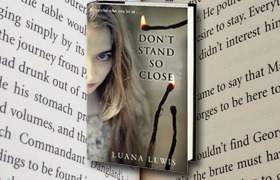Books
The Hardest Chapter: Luana Lewis
We caught up with author Luana Lewis on the publication of her novel Don’t Stand So Close to find out more about the difficulties in putting pen to paper.
Luana Lewis began her professional experience as a clinical psychologist, bringing to her work the authenticity that was so evident in the early novels of Patricia Cornwell and Kathy Reichs, proving she is definitely one to watch!
Check out an extract of the book over on our Facebook page.
Over to Luana:
‘The hardest chapter for me to write was the first. I knew it had to be compelling. That’s where the characters start and that’s where the reader starts.
I know how important I find the initial few pages when I’m making a decision on whether to buy. Either I’m reading them while standing by a shelf in a bookshop or I’ve downloaded a sample on my Kindle. If those pages don’t hook me, I don’t buy.
I always knew where and how Don’t Stand So Close would start. I had an image of a woman, a prisoner in her home by her own choice, standing at a large glass window and looking out onto her garden which was entirely covered in snow. A sort of surreal, dream-like image with implied danger and a tinge of excitement.
So I began my story – with the snow and with the question: What if Stella is alone at home and frightened of the outside world? What if a stranger, a defenceless young girl, knocked on the door asking for help?
I had my starting point. The difficult part was the pressure I felt to get this chapter right. Agents and publishers often make representation decisions based on the first chapter or two and as an unknown author, trying to stand out in the slushpile, I knew I had try hard to achieve two things:
1. I had to grab the reader’s interest and attention and not let go. (To paraphrase advice I’ve read often). This meant cutting and cutting and cutting – any extraneous meanderings or unnecessary information. Every unnecessary word had to go so as to keep the momentum of the story moving forwards.
2. At the same time, I had to create an emotional connection with Stella, my main character. I had to take the reader inside her head, and make her compelling enough to ensure that the reader would want to spend another 300 odd pages in her company.
While the first chapter’s the toughest to get right, it’s the first sentence that stands out. I read somewhere in the past few days – probably on Twitter – that this is the sentence that should somehow encapsulate the whole book or its primary emotion. I don’t know that any single sentence can do such a thing, but the first really ought to say something and be strong. Those words are the writer’s best opportunity to entice and engage the reader.
Here’s my first sentence: “At first, she ignored the doorbell.” To me, as the sentence stands on the page, occupying its own line and alone, it’s an invitation to read on, to find out who “she” is and why she wants to be alone, or needs to be, and what will happen when, inevitably, she answers the doorbell. It reflects her ambivalence about engaging with the outside world, which in a way is her quest throughout the novel.
Even once my book was in late-stage editing, the crafting of the first chapter didn2t end. It was relentless.
I have lost count of how many times I rewrote, edited and tweaked those 11 pages. When I thought they were just about right, which was at the point I received the book proof from my publisher – the very last chance to make changes – I found another 20 or so corrections. I could probably go on editing that first chapter forever. But at some point, it had to be good enough to be sent out into the world.’
A big thank you to Luana Lewis for sharing her writing experiences with us. If you want to find out more about Luana, you can follow her on Twitter!
The Book:


Please note: Moderation is enabled and may delay your comment being posted. There is no need to resubmit your comment. By posting a comment you are agreeing to the website Terms of Use.